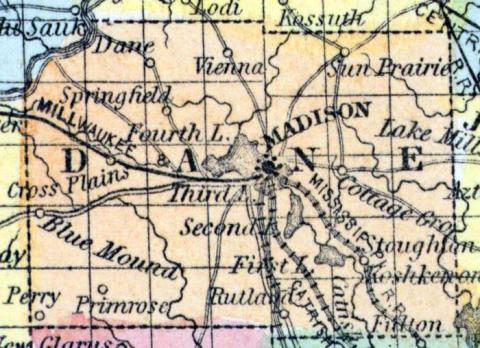DANE COUNTY, situated toward the southerly part of Wisconsin, with Wisconsin river on the northwest, and contains the “Four Lakes.” Area, 234 square miles. Seat of justice, Madison, which is also the capital of the state. Pop. in 1840, 314; in 1850, 9,366. (Fanning's, 1853)
DANE, a county in the S. central part of Wisconsin, contains 1235 square miles. The Wisconsin river forms a part of its N. W. boundary; it is also drained by the Sugar and Catfish rivers. The latter is the outlet of the Four Lakes, which lie in a row near the centre of the county, and are connected by short outlets. The largest of these lakes is six miles in length. The surface is diversified by hills of moderate height and gentle ascent. Tho soil is mostly calcareous and fertile. Prairies and oak openings occupy nearly tho whole area of the county. In the W. part is an eminence called the Blue mound, which is about 1000 feet high. Wheat, oats, Indian corn, butter, and pork are the staples. In 1850 the county produced 347,250 bushels of wheat; 122,290 of Indian corn; 243,601 of oats; 266,214 pounds of butter. It contained 4 churches, 8 newspapers, 2707 pupils attending public schools, and 98 attending academies or other schools. Limestone underlies a large part of the county. The streams afford valuable water-power. The county is intersected by the Milwaukee and Mississippi railroad, not yet finished. This county is one of the most important in the state, as it contains Madison, the capital of Wisconsin. Organized in 1839. Capital, Madison. Population, 16,639. (Baldwin's New and Complete Gazetteer of the United States..., 1854)
DANE, County, is bounded on the northwest by the Wisconsin river, by which it is separated from Sauk; on the north by Columbia, on the east by Dodge and Jefferson, south by Rock and Green, and west by Iowa. It was established from Milwaukee and Iowa, and attached to Iowa for judicial purposes December 7, 1836, and fully organized March 11, 1839. The seat of justice is at Madison, near the geographical centre of the county, and the Court House is the best in the State. Dane county contains about 1,250 square miles, mostly of good tillable land, and a fertile soil, well apportioned between woodland, openings and prairie, and is well adapted to grazing, and the raising of grain, roots and fruit. There is, in the county, considerable non-resident land which can be bought on reasonable terms. One of the most attractive features of the county is its beautiful lakes of clear, pure cold water, originating in deep springs. The Catfish river forms the outlet of these lakes, and passes from the northwest to the southeast completely through the chain known as the Four Lakes. The county is connected with the second judicial circuit, the second congressional district, and constitutes the eleventh senate district. It is divided into assembly districts as follows: 1st. The towns of Dunkirk, Christiana, Pleasant Springs and Albion. 2d. The towns of Cottage Grove, Deerfield, Sun Prairie, Medina, York and Bristol. 8d. The towns of Verona, Montrose, Oregon, Greenfield, Dunn and Rutland. 4th. The towns of Perry, Primrose, Blue Mounds, Springdale, Cross Plains, Middleton, Springfield, Berry, Black Earth, Roxbury and Dane. 5th. The village and town of Madison, and the towns of Bnrk, Blooming Grove, Westport, Vienna and Windsor. The county is watered by the Catfish and Sugar rivers, and Black Earth, Badfish, Token, Waterloo and Koskonong creeks. The population in 1836 was Ebenezer Brigham; 1838, 172; 1840, 314; 1842, 8,289; 1847, 10,935; 1850, 16,654. Farms, 1,511; manufactories, 87; dwellings, 3,510. County Officers: County Judge, N. Bishop Eddy; Clerk of the Court, Charles Lumm; Sheriff, Willet S. Main; Register, John B. Sweat; Clerk of Board Supervisors, Gabriel Bjornsen; District Attorney, Samuel H. Roys; Treasurer, Philo Dunning; Surveyor, Russel Babbitt; Coroner, Andrew Bishop. (John Warren Hunt, Wisconsin Gazetteer..., Madison, 1853)

